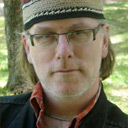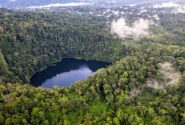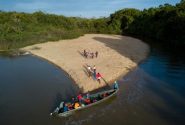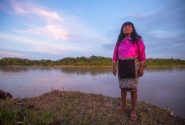
Ecosystems provide benefits known as services, ranging from water, carbon storage and biodiversity to aesthetic pleasure, recreational opportunities and spiritual uses. CIFOR/Aulia Erlangga
BOGOR, Indonesia (23 July, 2013) – Payments for environmental services (PES) can both save the environment and alleviate poverty: true, false or none of the above?
For two scientists, the goals and potential impact of PES are part of a longstanding debate that recently took a new turn.
Along with 32 other authors, Roldan Muradian – a senior researcher at Radboud University Nijmegen in the Netherlands – published ”Payments for ecosystem services and the fatal attraction of win-win solutions” in Conservation Letters, a journal that focuses on biological and social sciences.
Sven Wunder, a principal scientist with the Center for International Forestry Research (CIFOR), published a response in the same journal: “When payments for environmental services will work for conservation“.
The researchers said they are not overly concerned about whether PES stands for “ecosystem” or “environmental” services. Judging from their work, there are more profound differences, beginning with the very definition of PES.
THE ESSENCE OF PES
Ecosystems provide benefits known as services, ranging from water, carbon storage and biodiversity to aesthetic pleasure, recreational opportunities and spiritual uses. Through PES transactions, landowners or -users may receive cash or in-kind incentives in return for safeguarding or enhancing these benefits.
These transactions can be organized informally among buyers and sellers, or could be part of large-scale initiatives led by states and subsidized by donors. In Bolivia, for example, farmers living adjacent to Amboró National Park receive in-kind payments (beehives, barbed wire, fruit trees) to set aside forests for conservation forests.
“PES sounds simple because it’s one party compensating another for doing something they both agree on,” Wunder said. “But if multiple stakeholders are involved claiming different rights that are maybe not well-defined in terms of land use and land-use change, then suddenly it becomes complicated. Or maybe buyers are not sufficiently organized to reach an agreement to pay as a collective unit. Then, although there’s a good case for PES, it’s not going to work.”
Citing his own earlier work, Wunder defined the principle of PES as, “a voluntary, conditional transaction between at least one buyer and one seller of a well-defined service.”
“This is too narrow,” Muradian said. “What’s the point of a definition that can only describe a limited number of schemes? We need a different analytical framework to understand them.”
WIN-WIN OR WIN-SETTLE?
Another difference between the researchers lies in how they perceive PES in relation to integrated conservation and development projects (ICDPs). In a 2005 paper, Wunder described ICDPs and sustainable forest management as instruments designed to simultaneously increase incomes and conserve the environment. “Yet despite scattered successes,” he wrote, “neither approach has so far achieved major shifts in tropical land-use trends.”
In their paper in Conservation Letters, Muradian and his colleagues wrote that ICDPs arrived with the “promise of win-win solutions” for both people and the environment. And, like Wunder, they noted the success of ICDPs has been elusive. But they added that policy makers should learn from the unrealistic win-win expectations associated with ICDPs: “Today, we could be making a similar mistake with PES,” they wrote.
In his response, Wunder asked, “(A)re PES really part of the win-win family?” PES are a direct alternative to ICDPs, remunerating people for conserving ecosystems rather than investing in alternate livelihoods, he wrote. Citing earlier research, Wunder said PES are rather “win-settle”: achieving one goal, while making sure others are at least not worsened.
COMPENSATION: TRAP OR OPPORTUNITY?
Compensation – either cash or in-kind payment – is another sticking point. Expectations to counteract highly profitable but environmentally damaging behavior through payments may lead to the “trap” of increasing levels of compensation, Muradian said.
“When opportunity costs are huge, you need to move out of the market rationale to preserve ecosystems.” he said.
The “trap” can actually be an opportunity, and a major strength of PES, Wunder said. Accordingly, customizing compensation levels can be part of a transparent discussion about how much conservation really costs.
“Negotiated conservation such as PES is clearly not the easiest, nor the only legitimate way to achieve conservation, but arguably it is equitable conservation practice at its finest,” Wunder said.
NEXT STEPS
Both researchers agree on the need for more applied research. Muradian, now a visiting scholar at the Federal Rural University of Rio de Janeiro, is working on three empirical case studies related to watersheds.
Meanwhile, Wunder said he continues to analyze various PES cases, providing guidance on the most promising design options for different contexts.
“PES might work in certain circumstances, but in others they might not,” Muradian said. “That’s precisely why we need to increase our knowledge: under which particular institutional, cultural and behavioral settings can PES actually work?”
The two researchers have said they plan to meet informally so their debate may well spill from the pages of Conservation Letters into the alehouses of Rio de Janeiro.
Muradian said he is aware of a workshop co-organised by CIFOR on evaluation of forest conservation initiatives planned for December in Barcelona. The workshop will evaluate a host of approaches, including PES, protected areas and community forest management. In so doing, it hopes to intensify both the technical debate across disciplines and the science-policy dialogue on conservation.
“Skeptics are invited,” Wunder said.
For more information about the issues discussed in this article, please contact Sven Wunder, s.wunder@cgiar.org
This work forms part of the CGIAR Research Program on Forests, Trees and Agroforestry
We want you to share Forests News content, which is licensed under Creative Commons Attribution-NonCommercial-ShareAlike 4.0 International (CC BY-NC-SA 4.0). This means you are free to redistribute our material for non-commercial purposes. All we ask is that you give Forests News appropriate credit and link to the original Forests News content, indicate if changes were made, and distribute your contributions under the same Creative Commons license. You must notify Forests News if you repost, reprint or reuse our materials by contacting forestsnews@cifor-icraf.org.












